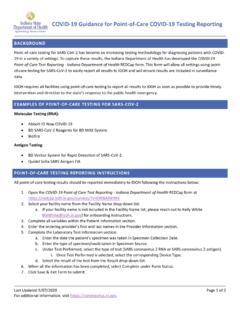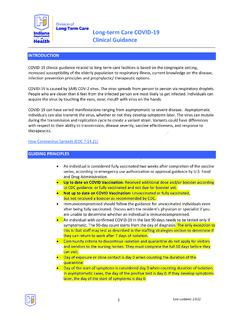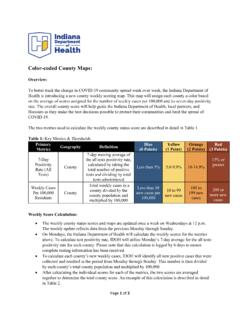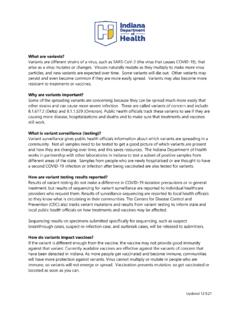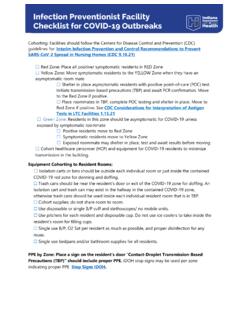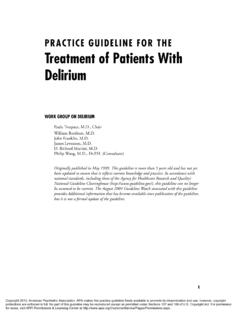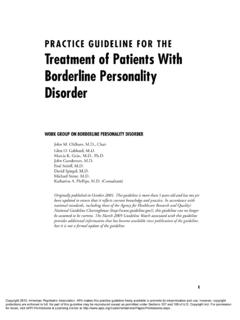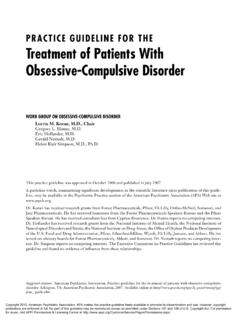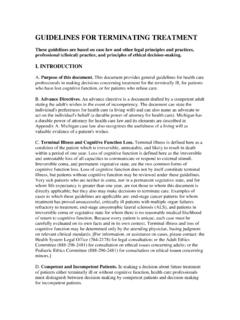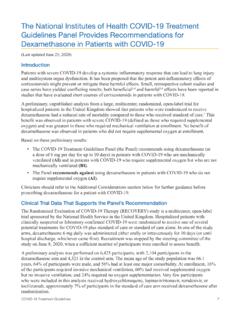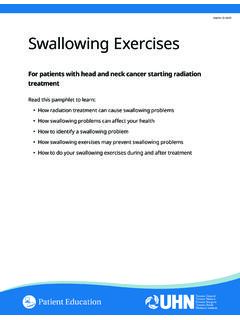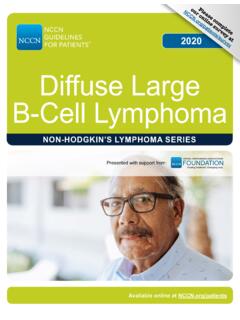Transcription of Outpatient Remdesivir Treatment for Nonhospitalized COVID ...
1 Outpatient Remdesivir Treatment for Nonhospitalized COVID -19 patients at Risk for Progression to Severe Disease Given our significant constraint on available Treatment resources to prevent severe illness, death, and hospitalization in at risk individuals it is necessary to provide additional Treatment options. Remdesivir , FDA approved for in-hospital Treatment of SARS-CoV-2, was studied in non-hospitalized at risk individuals as 3 infusions over 3 days and showed to lower risk of hospitalization and death by 87%.This approach is supported by the NIH Panel Statement on Anti-SARS-CoV-2 mAbs and RDV and Omicron | COVID -19 Treatment Guidelines ( ). It is expected that Remdesivir will be necessary as a Treatment option for at least the next 60 days, when the Omicron variant represents the majority of infections in a region and it is expected that bamlanivimab plus etesevimab and casirivimab plus imdevimab will not be effective.
2 The NIH Panel recommends the use of Remdesivir to treat non-hospitalized patients with mild to moderate COVID -19 who are at high risk of clinical progression (see list below). Remdesivir 200 mg IV on Day 1, then 100 mg once daily on Days 2 and 3 (BIIa) initiated as soon as possible and within 7 days of symptom onset. o Remdesivir should be administered in a setting where management of severe hypersensitivity reactions, such as anaphylaxis, is possible. patients should be monitored during the infusion and observed for at least 1 hour after the infusion. o patients who meet the following criteria are eligible: Non-hospitalized patients with COVID -19 who had symptom onset within the previous 7 days and who had at least one risk factor for disease progression.
3 Immunocompromised individuals not expected to mount an adequate immune response to COVID -19 vaccination or SARS-CoV-2 infection due to their underlying conditions, regardless of vaccine status (see Immunocompromising Conditions below): o patients who are within 1 year of receiving B-cell depleting therapies ( , rituximab, ocrelizumab, ofatumumab, alemtuzumab) 2 Last updated: o patients receiving Bruton tyrosine kinase inhibitors o Chimeric antigen receptor T cell recipientsPost-hematopoietic cell transplant recipients who have chronic graft versus host disease or who are taking immunosuppressive medications for another indication o patients with hematologic malignancies who are on active therapy o Lung transplant recipients o patients who are within 1 year of receiving a solid-organ transplant (other than lung transplant)
4 O Solid-organ transplant recipients with recent Treatment for acute rejection with T or B cell depleting agents o patients with severe combined immunodeficiencies o patients with untreated HIV who have a CD4 T lymphocyte cell count <50 cells/mm3 Anyone age >65 years old Anyone age <65 and >12 years old with Co-morbid conditions at risk for severe disease, hospitalization and death. Co-morbid conditions: Some of the most important risk factors include (listed alphabetically) age (risk increases with each decade after age 50),1 cancer, cardiovascular disease, chronic kidney disease, chronic lung disease, diabetes, immunocompromising conditions or receipt of immunosuppressive medications, obesity (body mass index 30), pregnancy, and sickle cell disease.
5 For a complete list of risk factors, including information on the relative risk of severe disease, see the CDC webpage Underlying Medical Conditions Associated with High Risk for Severe COVID -19. Of note, the likelihood of developing severe COVID -19 increases when a person has multiple Hospitals and facilities will likely need to prioritize further within the above groups secondary to limited supplies and staffing resources. In those instances, facilities may use tiered guidelines to prioritize such as Statement on Patient Prioritization for Outpatient Therapies | COVID -19 Treatment Guidelines ( ).
